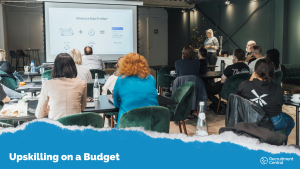How can employers build development plans that actually work? What’s the best way to close skill gaps and keep teams engaged without blowing the budget? This article shows practical steps to create growth plans that connect individual goals with business outcomes. It highlights how even small, well-aligned actions can lift retention, performance, and ROI across your workforce.
Ask any business leader in the sector and they’ll tell you it’s becoming harder to keep teams fully staffed, engaged, and confident in their skills. Across industries, hiring often feels more like plugging leaks than building momentum.
75% of employers say finding qualified people is their biggest challenge. As technology moves forward and skill gaps widen, it’s no wonder. New demands arrive faster than most teams can adapt.
It’s common to spend months recruiting, only to see another key role open when someone leaves. That’s why development planning has shifted far beyond optional training budgets or nice-to-have perks. A clear, practical growth plan is now one of the best ways to keep good people engaged and ready for what comes next. Without it, businesses risk losing good people and falling behind competitors who are acting now.
Without it, there’s little chance of staying ahead of rapid change or holding on to employees who want to remain productive and competitive. A future-ready workforce depends on a strong development plan. For employees, it shows that their growth matters and gives them confidence in an uncertain environment.
What Makes Development Plans Work
A development plan works best when everyone understands its purpose. It isn’t just a record of training courses. It’s a way to show how someone’s skills can grow in a direction that benefits both them and the business.
Plans often fall short when they stay too general. Relying on the same list of goals for every role leads to disengagement. If a plan doesn’t connect to real work, it becomes a paperwork exercise. You need a strategy that links goals directly to outcomes.
The SMART Goals framework keeps things practical. It pushes companies to set specific, measurable objectives that lead to real development outcomes. “Get better at data skills” isn’t clear. A stronger goal might be, “Finish a data analytics certification by October and use it to improve the next reporting cycle.”
It also helps to consider how learning happens. The 70-20-10 model shows that around 70% of skill development comes from daily work, 20% from coaching and mentoring, and 10% from formal courses.
That balance will look different for each team. Some employees prefer hands-on experiences, while others learn better through examples or structured steps. Shorter, targeted lessons can also make learning feel manageable. Many companies are now adopting microlearning – offering quick videos or guides staff can use on demand.
Whatever approach you choose, alignment is key. Development should balance individual aspirations with organisational goals.
A Framework for Strategic Development Planning
Development planning is easier with a clear process. Jumping straight into a list of courses or generic goals usually doesn’t last. For measurable outcomes, you need clarity and structure.
Step 1: Conduct a Skills Assessment and Gap Analysis
Start by understanding the skills your teams already have. Competency mapping doesn’t need to be complicated. Ask where projects flow well and where things get stuck. Think about which skills will matter more tomorrow than they did yesterday.
Look at the whole picture. Assess technical skills alongside soft skills, leadership qualities, and transferable strengths. Remember that some capabilities – like AI proficiency, data analysis, and digital literacy – are becoming essential across industries.
Step 2: Explore the Four Types of Development Plans
Once you’ve mapped the gaps, you can consider the right approach. Plans don’t all need to look the same. Depending on your needs, you might focus on:
- Skill-based plans – strengthen the abilities employees use most days.
- Succession plans – prepare people to step into crucial roles.
- Management development plans – help new leaders build confidence and clarity.
- Career transition plans – support employees moving into new areas of the business.
Your development plan might combine elements of more than one. What matters most is that it makes sense to you and your employees.
Step 3: Define Your Resource Allocation Strategy
Planning can stall if resources feel limited. Many companies set aside 2-5% of payroll for development, but there’s no set rule. Some invest much more, and research suggests that learning and development can have an ROI of over 350%. Research shows learning and development delivers an average ROI of 353%, so it’s one of the most measurable investments you can make.
If stronger development reduces turnover, constant recruiting, and repeated mistakes, it’s usually worth the investment. Development not only improves productivity but also makes your company more attractive to candidates.
If budgets are tight, consider cost-effective options like:
- Cross-training colleagues on each other’s tasks
- Mentoring programs
- Short online courses or microlearning resources
Technology can also help. Some companies use simple learning platforms to track progress, while others adopt AI-powered tools to recommend training or measure outcomes.
Step 4: Integrate Development into Culture
Plans work best when they fit naturally into the way people already work.
Remote and hybrid teams may need extra flexibility. Generational differences also play a role; early-career employees might focus on credibility, while later-career staff may want to mentor others.
Showing commitment to diversity and inclusion also matters. Employees are more likely to engage when development reflects different learning styles, life stages, and backgrounds, it feels genuine and inclusive.
From Plan to Performance
A development plan can look good on paper with goals, timelines, and responsibilities, but without careful implementation it won’t stick.
Launch with Intention
Involve your team from the start. Employees are more engaged when they’ve had input. Be clear on what success looks like, who’s responsible for what, and what resources are available. Even small details like setting up logins and access to materials early make a big difference.
Monitor and Evaluate Progress
Plans lose momentum when nobody follows up. Regular check-ins, whether weekly or monthly, keep goals alive. Ask simple questions: Are new skills showing up in daily work? Are people more confident? Is turnover stable?
Signs of success include:
- Longer retention because employees see a future in their role
- Faster project completion with fewer errors
- More staff ready to step into bigger jobs
- Teams handling more complex tasks independently
Quick conversations often uncover issues before they grow.
Keep Improving
Your business and industry will continue to evolve, so development plans shouldn’t stay static. Schedule reviews, adjust when priorities change, and gather regular feedback. Recognise progress and document lessons learned so the next plan starts stronger.
Turning Plans into Real Progress
There’s no one-size-fits-all recipe for strategic development planning. Every organisation has its own mix of challenges, priorities, and learning styles.
What’s consistent is that people want their skills to matter. They want a clear path forward, especially when the future feels uncertain.
A strong development plan gives them that path. It shows growth isn’t something they need to figure out alone.
Getting started doesn’t need to be complicated. Begin with a clear goal, an honest conversation with your team, and a small investment in the right resources. Even a simple, well-aligned plan can make a lasting difference.

















